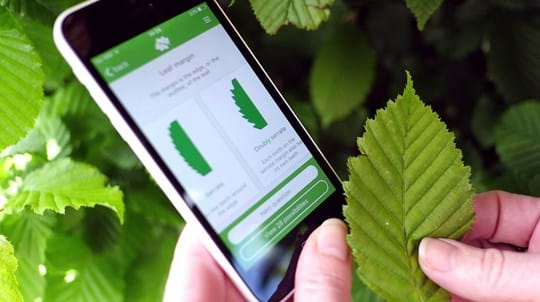
Credit: Laurie Campbell / WTML
Leaves
Dark green, glossy and oval. Younger plants have spiky leaves, but the leaves of older trees are much more likely to be smooth. Leaves in the upper parts of the tree are also likely to be smooth.
Festive, neat and prickly. Holly is a well-loved shrub that shelters birds and gives hedgehogs a cosy place to hibernate.
Common name: holly
Scientific name: Ilex aquifolium
Family: Aquifoliaceae
Origin: native
Mature trees can grow up to 15m and live for 300 years. The bark is smooth and thin with lots of small, brown 'warts', and the stems are dark brown.
Look out for: its bright red berries and shiny, leathery leaves that usually have spiny prickles on the edges.
Identified in winter by: its dark, glossy leaves which remain green year-round.

Credit: Laurie Campbell / WTML
Dark green, glossy and oval. Younger plants have spiky leaves, but the leaves of older trees are much more likely to be smooth. Leaves in the upper parts of the tree are also likely to be smooth.

Credit: Michael Grant / Alamy Stock Photo
Holly is dioecious, meaning that male and female flowers occur on different trees. Flowers are white with four petals. They bloom any time between early spring and the very beginning of summer, depending on the climate.

Credit: Derek Lefley / WTML
Once pollinated by insects, female flowers develop into scarlet berries which can remain on the tree throughout winter.
Some of the many cultivated and variegated varieties that exist.
Scientists recently discovered that holly trees adjust their spiky armour in response to hungry animals and changing environments. They can produce some prickly leaves to fend off nibblers while others remain smooth.
This leafy transformation happens through epigenetic modification. This is a fascinating way that organisms adjust their gene expression without actually changing their DNA. So although the DNA of all holly trees is the same, they can switch off or on different traits to adapt to their environment.

Have you noticed buds bursting into leaf or fruit ripening in the hedgerows? Tell us what's happening to the trees around you and help scientists track the effects of climate change on wildlife.
Take part in our Nature's Calendar surveyThe holly is native in the UK and across Europe, North Africa and western Asia. It is common in woodland, scrub and hedgerows, especially in oak and beech woodland.
The mistle thrush is known for vigorously guarding the berries of holly in winter to prevent other birds from eating them.
Holly provides dense cover and good nesting opportunities for birds, while its deep, dry leaf litter may be used by hedgehogs and small mammals for hibernation.
The flowers provide nectar and pollen for bees and other pollinating insects. The leaves are eaten by caterpillars of the holly blue butterfly, along with those of various moths, including the yellow-barred brindle, double-striped pug and the holly tortrix. The smooth leaves found at the tops of holly trees are a winter source of food for deer.
The berries are a vital source of food for birds in winter, and small mammals, such as wood mice and dormice.
Holly branches have long been used to decorate homes in winter. The tree was seen as a fertility symbol and a charm against witches, goblins and the devil. It was thought to be unlucky to cut down a holly tree.
Holly wood is the whitest of all woods, and is heavy, hard and fine-grained. It can be stained and polished and is used to make furniture or in engraving work. It is commonly used to make walking sticks. Holly wood also makes good firewood and burns with a strong heat.
Holly branches are still used to decorate homes and make wreaths at Christmas.

Helen Keating • 05 Dec 2022
Transform your home into a woodland wonderland this Christmas with our easy ideas for festive, foraged home decor.
Be inspiredThe holly leaf miner may cause damage to foliage and holly leaf blight may cause dieback.

Blog
Kate Lewthwaite • 24 Nov 2020

Trees woods and wildlife
Use our free Tree ID app for Android and iPhone to identify the UK's native and non-native trees.

Shop
We have single trees and tree packs to meet your needs, from wildlife to woodfuel. Delivery is free.
External link